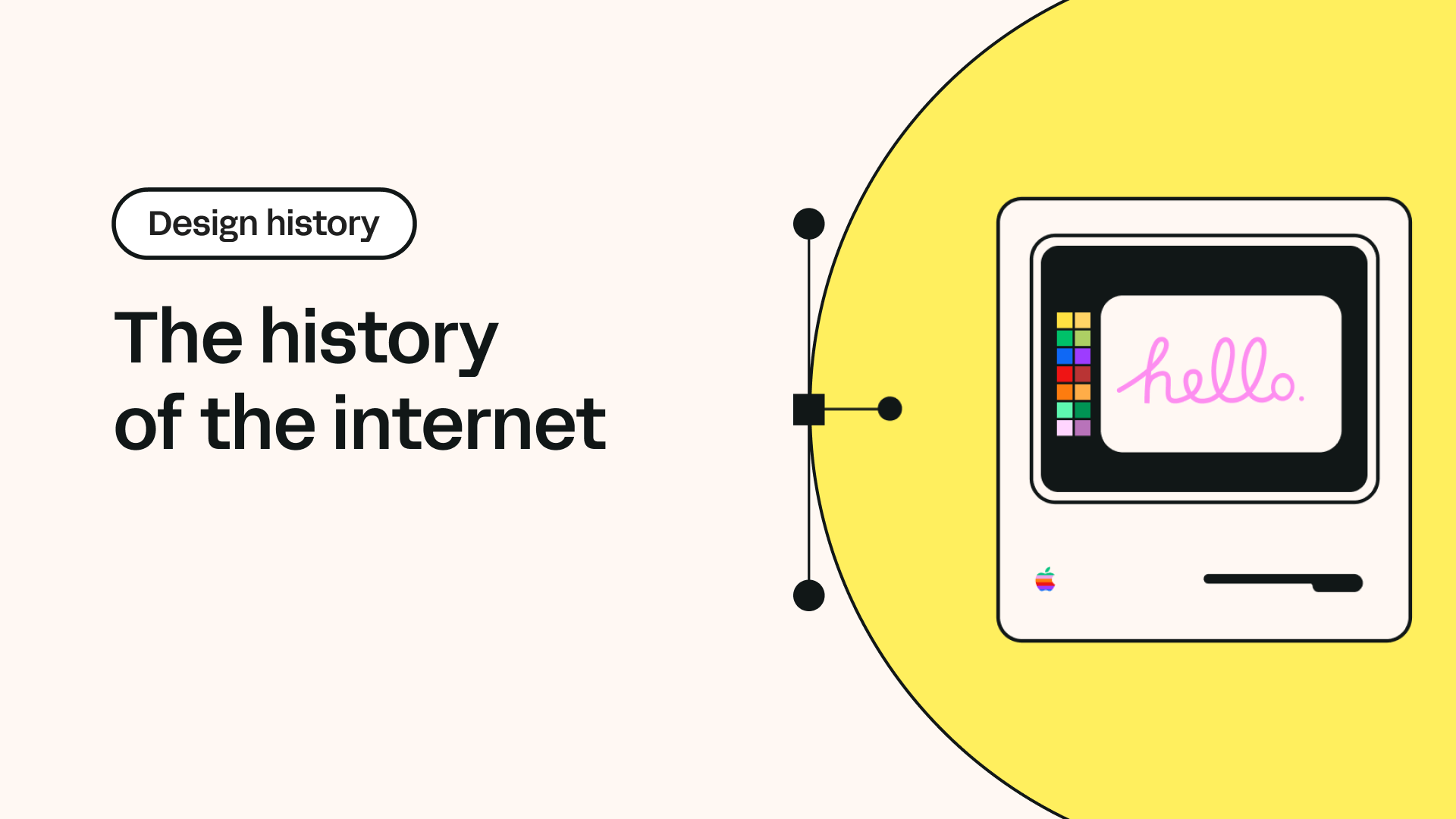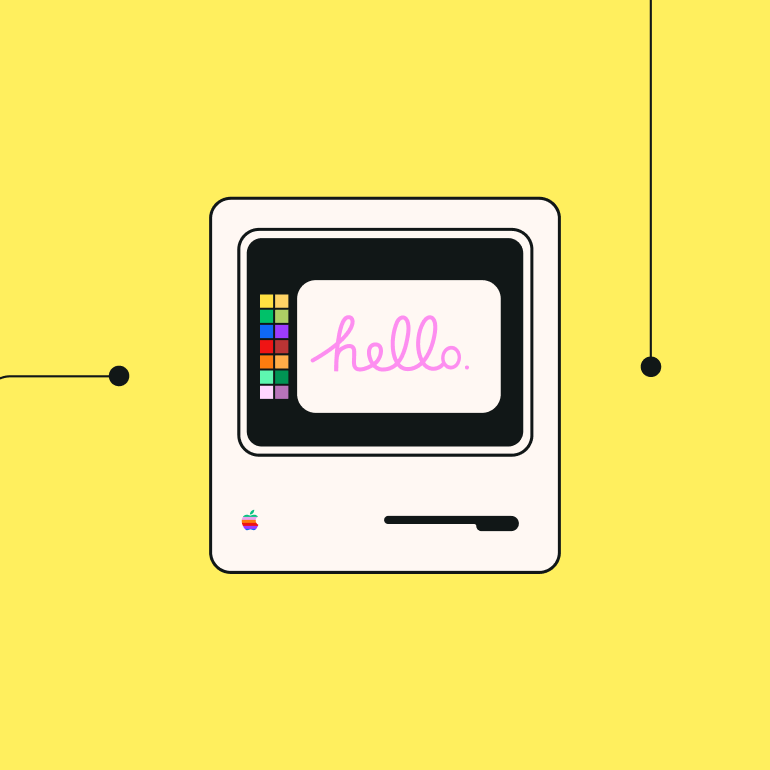In the beginning stages of the internet, only a select group of government agencies and universities had access to this new technology. However, as the internet began to expand and evolve, it quickly became apparent that it had the power to change the way we work, communicate, and live. From the first email sent in 1971 to the public launch of the first website in 1991, the internet has undergone tremendous growth and development.
As the internet continued to evolve, it changed how we do business, interact with each other, and access information. Today, the internet is a vital part of our daily lives and critical in many aspects of modern society.
Jumpstart your ideas with Linearity Curve
Take your designs to the next level.

The article will analyze the history of the internet, from its early beginnings to its current state. We'll explore the key technologies and innovations that have shaped the internet and how it has affected our society. From the first search engines to the development of social media, we will cover the highlights of the development of the internet. We will also examine the challenges and opportunities that the internet presents and look at the future of this powerful technology.
The spark that ignited the internet: the information theory
Information theory is a branch of mathematics and electrical engineering that studies the representation, transmission, and manipulation of information. Claude Shannon developed the field in 1948, and it is the foundation of modern communication systems, including telecommunications, computer science, and data storage.

Information theory is concerned with understanding the fundamental limits of information transmission and compression and how these limits can be approached or achieved. It also studies the amount of information in a message and how it can be measured and quantified.
The base concept in information theory is that of entropy. It measures the amount of uncertainty or randomness in a message. Entropy can be used to determine the minimum number of bits necessary to represent a message and to establish the maximum rate at which data can be transmitted over a channel without errors.
Information theory is also closely related to coding theory and cryptography, as it provides a mathematical framework for understanding the properties of error-correcting codes and encryption methods.
Information theory has various applications in telecommunications, data compression, data storage, data analysis, machine learning, and artificial intelligence. It is also used in fields like physics, biology, psychology, and linguistics and has provided fundamental insights into the nature of information and communication.
What is the world wide deb?
The World Wide Web (WWW or Web) is a system of interlinked hypertext documents accessed via the Internet. It was created by Sir Tim Berners-Lee in 1989 and is considered an essential part of the Internet. The web allows users to access a wide range of information using a web browser, including text, images, videos, and other multimedia content.
Web pages are written in a markup language called HTML (Hypertext Markup Language), which is used to create the structure and layout of the pages. Web pages are linked using hyperlinks, clickable links that allow users to navigate between pages.

The web also uses other technologies such as URLs (Uniform Resource Locators), which are addresses that identify the location of a web page, and HTTP (Hypertext Transfer Protocol), which is the protocol used to transfer data between web servers and clients (web browsers).
The World Wide Web has proliferated since its creation, becoming a ubiquitous and essential tool for communication, information sharing, and commerce. Today, the web is home to billions of pages and is used by billions of people worldwide to access information and connect with others.
Early internet history of the 50s and 60s: laying the foundation
During the 1950s and 1960s, the Internet as we know it today did not yet exist, but the early foundations for computer networking were being laid.
In the late 1950s, the United States Department of Defense's Advanced Research Projects Agency Network (ARPANET) began funding research into computer networking. This research was led by a team at MIT, which developed the concept of packet switching, a technique for sending data over a network in small packets rather than as a single large message.

In the early 1960s, the Massachusetts Institute of Technology (MIT), the RAND Corporation, and the System Development Corporation (SDC) began working on developing the first computer networks. They focused on creating a network that could connect multiple computers, allowing them to share resources and communicate with each other.
In 1969, the first successful packet-switching network, the ARPANET, was created, connecting four universities in California and Utah. This network was the first to use the packet switching technique and laid the foundation for the modern Internet.
The first internet-connected devices were large mainframe computers connected via dedicated, high-speed lines.
On the verge of a public breakthrough: the internet history of the 70s and 80s
During the 1970s and 1980s, the Internet continued to evolve and expand, developing key technologies and standards that would shape its future.
In the 1970s, the Internet Protocol (IP) was developed, establishing the basic framework for sending and receiving data over the network. This was followed by the development of the Transmission Control Protocol (TCP) in the early 1980s, which ensured that data was transmitted reliably across the network. Together, these protocols formed the foundation of the Internet Protocol Suite, also known as TCP/IP, which is still the foundation of the Internet today.

In the late 1970s, the first email systems were created, allowing for the exchange of electronic messages between computers. This quickly became one of the most widely used applications on the Internet.
The first email
In the year 1971, the first email was sent by a computer engineer named Ray Tomlinson. Tomlinson was working on a project at Bolt Beranek and Newman (BBN), a research firm that the U.S. Department of Defense contracted to develop the ARPANET, the precursor to the modern Internet.
Tomlinson was working on a program called SNDMSG, which allowed users to send short messages between computers on the ARPANET. He realized that by using the "at" symbol (@) to separate the user's name from the destination address, he could create a system for sending electronic messages between users on different computers.
The first email sent by Tomlinson was a test message to himself, in which he confirmed that the system worked. The exact content of this first email has been lost, but Tomlinson has stated that it was most likely a short message, something like "something like QWERTYUIOP, which I knew would be unlikely to be typed by accident."
The first email system was simple and not widely used. It took a few more years for email to become widely adopted as a communication tool. Still, it quickly became one of the most popular and widely used applications on the Internet.
In the 1980s, the first commercial Internet Service Providers (ISPs) began to appear, allowing individuals and businesses to access the Internet without having to be connected to a university or government network.
Enter the Enchanting World of Children's Book Illustrations
Discover the magic of storytelling through art. Learn about the creative process behind enchanting children's book illustrations.
The introduction of the Domain Name System (DNS) in 1983 allowed for more user-friendly addresses, such as www.example.com, instead of the complex numerical IP addresses used previously.
In the late 1980s, the first graphical web browsers, such as WorldWideWeb, made it easier for users to navigate the Internet and view web pages. This critical development made the web more accessible to a broader audience.
The 80s also saw the emergence of the first experiments with wireless networking, such as the ALOHAnet in Hawaii, which was one of the first wireless networks to use packet switching.
Overall, the 70s and 80s were a decade of rapid growth and innovation for the Internet, laying the foundation for the explosion of growth and usage in the following decades.
The pioneer phase - the internet of the 90s: web 1.0
The first website
The first website was created by Sir Tim Berners-Lee, a British computer scientist, in 1991. The website was hosted on a NeXT computer at CERN (European Organization for Nuclear Research) located in Switzerland. It was primarily used to share information about the World Wide Web project. The website was simple, primarily text-based, and provided information about the project, including its goals, the technologies used, and how to use them.
The first website's URL (Uniform Resource Locator) was http://info.cern.ch/hypertext/WWW/TheProject.html, and it can still be viewed on the Wayback Machine, an Internet archive that allows users to view old versions of websites.
This website was considered the first step in the creation of the World Wide Web, it was the first website that could be accessed via the Internet, and it demonstrated the potential of the web as a tool for sharing and distributing information.
Web 1.0 is the first publicly accessible version of the World Wide Web during the 1990s. It was a static, read-only version of the web, where users could primarily view and read the content without interacting or contributing significantly.

Web 1.0 was characterized by a few key features:
- It was primarily text-based, with limited use of images, videos, and other multimedia content.
- Web pages were often simple and plain in design, with limited use of colors, graphics, and animations.
- Navigation was mainly based on hyperlinks, and web pages were often organized in a hierarchical structure.
- Web 1.0 was mainly used to share information and access specific data types, such as encyclopedias and research papers.
- The concept of e-commerce did not exist yet. Thus there were limited opportunities for online shopping or financial transactions.
- Website creation was mainly the domain of experts, such as web developers and programmers, and most of the content was created by organizations or institutions.
- The introduction of web browsers, such as Mosaic and, later, Netscape, made it easy for users to navigate and access information on the internet.
As the internet grew in popularity, personal computers (PCs) began to be connected to the network via modems, which allowed users to access the internet over standard telephone lines.

Web 1.0 was the foundation for the web as we know it today, and although it was limited in its capabilities, it paved the way for the development of more interactive and dynamic web technologies in the following years and the emergence of Web 2.0.
Late 90s to early 2000s internet: web 2.0
In the early 2000s, the widespread adoption of broadband internet access, such as DSL and cable, made it possible for users to access the internet at much faster speeds, allowing for the development of new, bandwidth-intensive applications such as streaming video and online gaming.
Web 2.0 refers to a second generation of the World Wide Web that emphasizes user-generated content, social networking, and interactivity. It represents a significant shift from the static, one-way communication model of the early web to a dynamic, collaborative, and participatory platform.
The term "Web 2.0" was coined in 2004 by Tim O'Reilly, the founder of O'Reilly Media, to describe a new wave of web-based technologies and applications that were emerging at the time. These technologies enabled users to contribute to the web, share their content, and interact with others in new ways.

Web 2.0 is characterized by a few key features:
- It is more interactive and dynamic, allowing users to view content and contribute, share, and collaborate with others.
- It is based on user-generated content, with platforms such as social media, blogs, wikis, and forums enabling anyone to publish and share content easily.
- It is more personalized, with features like social networking and recommendation systems.
- It is more interconnected with RSS, APIs, and Mashups, which allows for the seamless sharing and integration of data and services between different sites.
- It is more focused on community and collaboration, with platforms like Wikipedia and YouTube allowing collective knowledge-building and sharing.
- It is more business-oriented, with the rise of e-commerce and online marketplaces, such as Amazon and eBay, and new forms of online advertising emerged.
Overall, Web 2.0 represents a significant shift in how we use the web, from a passive consumption model to an active, collaborative, and participatory one. It has transformed the way we communicate, share information, and connect with others online.
Web 2.0 has significantly changed how we interact, share, and consume online information. It has made the web more participatory and enabled new forms of communication, collaboration, and e-commerce.
The internet of the mid-2000s to today: web 3.0
Web 3.0 is the next evolutionary step of the World Wide Web, often referred to as the "Semantic Web," which is a vision for the future of the web where information is more connected, intelligent, and easily understandable by machines. It aims to make the web more meaningful and valuable by creating a web of data that can be understood, shared, and linked by machines and people.
The rise of mobile devices and wireless internet access has made it possible for people to access the internet from virtually anywhere and has led to the development of new internet-based applications and services such as social media and cloud computing.
Web 3.0 is characterized by a few key features:
- It is based on using technologies, which are formal representations of concepts, their properties, and relationships that allow data to be understood and shared across different systems.
- It is more intelligent, with artificial intelligence and machine learning technologies, that can process and analyze large amounts of data, extract insights, and make predictions.
- It is more decentralized, with the use of blockchain and distributed ledger technologies, that enable the creation of decentralized applications (dApps) and services that are not controlled by any single entity.
- It is more secure, with advanced security technologies, such as homomorphic encryption, that protect user data and enable new forms of privacy-preserving data sharing.
- It is more interactive and immersive, with virtual and augmented reality, enabling new forms of user experiences and interactions.

Web 3.0 is still a largely abstract and developing concept, and many of the technologies considered part of Web 3.0 are still in their infancy. However, Web 3.0 is expected to bring significant advancements in areas such as semantic search, knowledge representation, artificial intelligence, and how data is shared, stored, and accessed.
The future of the internet
The future of the Internet is likely to be shaped by a number of emerging technologies and trends. Some of the key areas that are likely to have a dramatic impact on the future of the Internet include
Machine learning and artificial intelligence: These technologies are already being used to improve search engines, personalize online experiences, and automate various tasks. They are expected to become even more powerful and integrated into all aspects of the Internet, enabling new forms of intelligent applications and services.

- The Internet of Things (IoT): The term signifies the growing network of connected devices, sensors, and other "things" that can collect and share data over the Internet. The IoT is expected to become even more pervasive in the future, enabling new forms of automation, monitoring, and control in a wide range of industries and applications.
- 5G and 6G networks: The next generation of mobile networks, 5G and 6G, will offer faster speed, a lower latency, and greater capacity than current networks. This will enable new applications, such as immersive virtual and augmented reality, and more efficient and reliable communications for the IoT.
- Blockchain and decentralization: Blockchain technology and decentralization will enable new decentralized applications (dApps) and services that are not controlled by any single entity. This is expected to bring new opportunities for secure, transparent, and efficient online transactions and new forms of online communities and marketplaces.

- Quantum internet: Quantum internet is a research field that aims to create a new internet based on quantum-mechanical principles. It is expected to bring new forms of secure communication and forms of computation and sensing.
- Privacy and security: The future of the Internet will likely be shaped by the ongoing debate about privacy and security. As more data is collected and shared, the need for greater privacy protections and more secure data management will become increasingly important.
Overall, the future of the Internet will likely be characterized by increased intelligence, connectivity, and decentralization, with the emergence of new technologies and applications that will change how we live, work and communicate.
Ready to create brand assets that pack a punch?
Visit our Academy for free marketing design courses.
The future of the internet and its impact on design software:
The future of the internet is expected to have a significant impact on the design world. Here are a few ways that this might happen:
- Virtual and augmented reality: As virtual and augmented reality technology continues to advance, we'll likely see more and more designers using these tools to create immersive and interactive experiences for users. This could change how we interact with websites and apps and open up new possibilities for e-commerce and product design.
- Increased use of artificial intelligence and machine learning: These technologies are already being used to create more personalized and intuitive user experiences, but they're expected to become even more sophisticated in the future. This could lead to the development of more advanced and intelligent interfaces, which will require designers to think differently about how they create user experiences. As these technologies continue to advance, design software could use them to help users create designs more quickly and easily. For example, AI could assist users with tasks such as creating complex shapes, removing an image background, converting raster images into vector shapes, designing layouts and color palettes.
- Greater emphasis on accessibility: As the internet becomes more widely used and accessible to people with disabilities, designers will need to ensure that their work is inclusive and usable for everyone. This will require a greater focus on accessibility principles and guidelines.
- Greater emphasis on data visualization: With the growing amount of data being generated by the internet, designers will likely need to develop more advanced skills in data visualization to help users make sense of this information.
- Cloud-based software: With the internet becoming more powerful, we'll likely see more vector design software moving to the cloud. This will allow designers to access their work from anywhere, collaborate with others in real time, and take advantage of the processing power and storage capabilities of the cloud.
- Improved collaboration features: With the internet making it easier for people to work together from different locations, vector design software will likely have to adapt to make collaboration more seamless. This could include features like real-time commenting, version control, and the ability to share and edit files with others.
- Greater integration with other software: As the internet and technology continue to evolve, vector design software will likely need to integrate with other tools, such as 3D modeling software, animation software, and web development tools, to provide a more comprehensive design experience
The future of the internet is likely to bring new challenges and opportunities for vector design software. It will require them to be adaptable and innovative and to think about how the software can be used in new and different ways. The software will need to keep up with the changing needs of the users and advances in technology to make the design experience more seamless and efficient.
We at Linearity already have many of these technologies implemented into our software. Our AI-powered feature Auto Trace uses advanced algorithms to vectorize a raster image. The latest AI-driven feature from Linearity, Background Removal, removes the background from a raster image with just one tap. You can update and sync your documents across your devices via iCloud and preview your artwork via AR.
Linearity Curve's use of AI in its Auto Trace and Background Removal features is a game-changer in graphic design. With its advanced machine learning capabilities and algorithms, Linearity Curve makes the design process faster, more efficient, and more accurate than ever. Whether you are a professional graphic designer or a hobbyist, Linearity Curve's AI-powered features can help you achieve your vision quickly and precisely.
As we continue to rely increasingly on technology in our daily lives, embracing and leveraging AI to create more innovative and effective solutions is essential. Linearity Curve's use of AI is an excellent example of this trend, representing a significant step forward for the design community. By adopting these AI-powered tools, designers can unlock their creativity and express their ideas in new and exciting ways.

If you are a designer looking to stay ahead of the curve (pun intended!) and take your work to the next level, try Linearity Curve. With its powerful AI features and user-friendly interface, it is sure to become an essential tool in your creative arsenal. Let's embrace the future of design and unlock our full potential with Linearity Curve and AI!
Jumpstart your ideas with Linearity Curve
Take your designs to the next level.


Share this!
Marion Gerlinger
Marion is a contributing writer to the Linearity Blog.


:quality(75))
:quality(75))



:quality(75))




